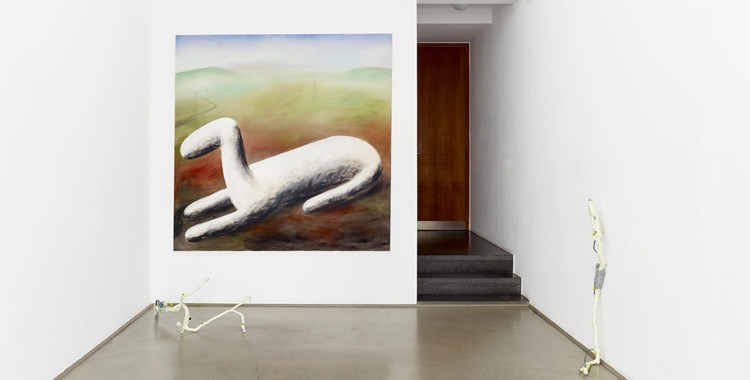Ancient Carriers
11 Jun - 25 Jul 2015
ANCIENT CARRIERS
With Magnus Andersen, Dorota Jurczak, Veit Laurent Kurz, Viola Relle and Andreas Schulze.
11 June – 25 July 2015
Curated by Saim Demircan
Ancient Carriers
by Saim Demircan
‘Ancient Carriers’ looks to the often-denigrated genre of fantasy as an alternative form of evolution, or passage of data flow. The works in the show draw heavily on imagined realms, mythic objects and fantastical imagery more associated with the past, and the aesthetic of pre-modern and medievalist forms. Deploying craft-based and bespoke techniques, or hobbyist aesthetics, they re-enchant a divided world of nature and culture.
Veit Laurent Kurz’s sculpted Scepters for example meld plants, analogue machine parts, USB ports and flash drives, eyes, and sometimes sprout hands. Collected together, they slowly evolve around the space in front of Andreas Schulze’s Untitled (2000) – a gigantic, indefinable hybrid of animal and object that sits within surrounding countryside.
The pastoral also appears as a backdrop in Magnus Andersen’s post-technological landscapes, in which a far-flung race of children manages a society that has reverted to rural methods of taxation, tolling and exchange – as exemplified in Tax Boy (2014). Seen in this light, Viola Relle’s ceramic objects – hybrid forms with practical and ceremonial use-values – also have an association with trade, or the transport of goods as they sometimes resemble an Amphora: ancient storage containers. However, inside the bases of Relle’s ceramics are carved, painted and glazed messages, or ‘stories’, that make them carriers of information similar to the storage devices embedded in Kurz’s sculpture.
Meanwhile Dorota Judczak’s lithographic prints of matchstick heads with facial features – both human form and technological tool – could be seen in relation to contemporary pictograms, or ‘icons’ now popularly used by software programs. Similar icons, or ‘emojis’ also appear carved into the wooden frames of Andersen’s work – contemporary symbols rendered ancient in his imagined future.
As such, each of the artists in the exhibition contribute to the idea of hybridization between nature and culture; ‘hybrids’ that, as Eric Davis describes in TechGnosis, ‘are both natural and cultural, real and imagined, subject and object.’ The so-called ‘Great Divide’ between the two – attributed to modernization and philosophically founded during the Enlightenment – means culture is constantly influenced by technology yet doesn’t change nature.
With Magnus Andersen, Dorota Jurczak, Veit Laurent Kurz, Viola Relle and Andreas Schulze.
11 June – 25 July 2015
Curated by Saim Demircan
Ancient Carriers
by Saim Demircan
‘Ancient Carriers’ looks to the often-denigrated genre of fantasy as an alternative form of evolution, or passage of data flow. The works in the show draw heavily on imagined realms, mythic objects and fantastical imagery more associated with the past, and the aesthetic of pre-modern and medievalist forms. Deploying craft-based and bespoke techniques, or hobbyist aesthetics, they re-enchant a divided world of nature and culture.
Veit Laurent Kurz’s sculpted Scepters for example meld plants, analogue machine parts, USB ports and flash drives, eyes, and sometimes sprout hands. Collected together, they slowly evolve around the space in front of Andreas Schulze’s Untitled (2000) – a gigantic, indefinable hybrid of animal and object that sits within surrounding countryside.
The pastoral also appears as a backdrop in Magnus Andersen’s post-technological landscapes, in which a far-flung race of children manages a society that has reverted to rural methods of taxation, tolling and exchange – as exemplified in Tax Boy (2014). Seen in this light, Viola Relle’s ceramic objects – hybrid forms with practical and ceremonial use-values – also have an association with trade, or the transport of goods as they sometimes resemble an Amphora: ancient storage containers. However, inside the bases of Relle’s ceramics are carved, painted and glazed messages, or ‘stories’, that make them carriers of information similar to the storage devices embedded in Kurz’s sculpture.
Meanwhile Dorota Judczak’s lithographic prints of matchstick heads with facial features – both human form and technological tool – could be seen in relation to contemporary pictograms, or ‘icons’ now popularly used by software programs. Similar icons, or ‘emojis’ also appear carved into the wooden frames of Andersen’s work – contemporary symbols rendered ancient in his imagined future.
As such, each of the artists in the exhibition contribute to the idea of hybridization between nature and culture; ‘hybrids’ that, as Eric Davis describes in TechGnosis, ‘are both natural and cultural, real and imagined, subject and object.’ The so-called ‘Great Divide’ between the two – attributed to modernization and philosophically founded during the Enlightenment – means culture is constantly influenced by technology yet doesn’t change nature.

